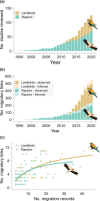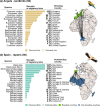Connectivity between countries established by landbirds and raptors migrating along the African-Eurasian flyway
- PMID: 36073347
- PMCID: PMC10107209
- DOI: 10.1111/cobi.14002
Connectivity between countries established by landbirds and raptors migrating along the African-Eurasian flyway
Abstract
The conservation of long-distance migratory birds requires coordination between the multiple countries connected by the movements of these species. The recent expansion of tracking studies is shedding new light on these movements, but much of this information is fragmented and inaccessible to conservation practitioners and policy makers. We synthesized current knowledge on the connectivity established between countries by landbirds and raptors migrating along the African-Eurasian flyway. We reviewed tracking studies to compile migration records for 1229 individual birds, from which we derived 544 migratory links, each link corresponding to a species' connection between a breeding country in Europe and a nonbreeding country in sub-Saharan Africa. We used these migratory links to analyze trends in knowledge over time and spatial patterns of connectivity per country (across species), per species (across countries), and at the flyway scale (across all countries and all species). The number of tracking studies available increased steadily since 2010 (particularly for landbirds), but the coverage of existing tracking data was highly incomplete. An average of 7.5% of migratory landbird species and 14.6% of raptor species were tracked per country. More data existed from central and western European countries, and it was biased toward larger bodied species. We provide species- and country-level syntheses of the migratory links we identified from the reviewed studies, involving 123 populations of 43 species, migrating between 28 European and 43 African countries. Several countries (e.g., Spain, Poland, Ethiopia, Democratic Republic of Congo) are strategic priorities for future tracking studies to complement existing data, particularly on landbirds. Despite the limitations in existing tracking data, our data and results can inform discussions under 2 key policy instruments at the flyway scale: the African-Eurasian Migratory Landbirds Action Plan and the Memorandum of Understanding on the Conservation of Migratory Birds of Prey in Africa and Eurasia.
Conectividad entre países establecida por aves terrestres y rapaces que migran a través del corredor aéreo africano-euroasiático Resumen La conservación de las aves que migran grandes distancias requiere de una coordinación entre los varios países conectados por los movimientos de estas especies. La expansión reciente de los estudios de rastreo está descubriendo novedades en estos movimientos, aunque gran parte de esta información está fragmentada y es inaccesible para quienes practican y elaboran las políticas de conservación. Sintetizamos el conocimiento actual sobre la conectividad establecida entre países por las aves terrestres y rapaces que migran a través del corredor aéreo africano-euroasiático. Revisamos los estudios de rastreo para compilar los registros migratorios de 1229 aves, de los cuales derivamos 544 conexiones migratorias, con cada conexión correspondiendo a la conexión que tiene una especie entre un país europeo en donde se reproduce con un país de la África subsahariana en donde no se reproduce. Usamos estas conexiones migratorias para analizar las tendencias informativas en patrones espaciales y temporales de conectividad por país (en todas las especies), por especie (en todos los países) y a escala del corredor aéreo (en todas las especies y en todos los países). El número de estudios de rastreo disponibles incrementó gradualmente a partir de 2010 (particularmente para las aves terrestres), pero la cobertura de los datos de rastreo existentes estaba incompleta. Se rastreó en promedio 7.5% de especies de aves terrestres migratorias y 14.6% de aves rapaces por país. Existían más datos de los países del centro y oeste de Europa, los cuales estaban sesgados hacia las especies de mayor tamaño. Proporcionamos varias síntesis a nivel de especie y país de las conexiones migratorias que identificamos a partir de la revisión de estudios, las cuales involucran a 123 poblaciones de 43 especies que migran entre 28 países europeos y 43 países africanos. Varios países, como España, Polonia, Etiopía y la República Democrática del Congo son prioridades estratégicas para complementar los datos existentes en los siguientes estudios de rastreo, en especial para las aves terrestres. A pesar de las limitaciones que tienen los datos de rastreo existentes, nuestros datos y resultados pueden orientar las discusiones con dos instrumentos claves para las políticas: el Plan de Acción de las Aves Terrestres Migratorias Africanas-Euroasiáticas y el Memorando de Entendimiento sobre la Conservación de las Aves Rapaces Migratorias de África y Eurasia.
《世界自然保护联盟 (IUCN) 红色名录》设定的标准是评估物种灭绝风险以及在适当的情况下宣布生物灭绝的黄金标准。然而, 与所有其它濒危等级不同的是, “灭绝”等级缺乏一个确定该等级的量化框架。鉴于划分这个等级存在主观性, 我们访问调查了研究多种类群的专家评估员, 以探究他们宣布物种灭绝时考虑的因素。本研究利用选择实验的方法, 调查了来自世界自然保护联盟物种生存委员会专家组和工作组的 674 名专家。我们发现, 在推断物种灭绝时, 数据可获得性、距离最后一次发现的时间、可监测性、栖息地可获得性和种群下降情况都是评估者关注的重要属性。曾参与红色名录工作的受访者在分析物种灭绝时, 更重视数据可获得性、距离最后一次发现的时间和可监测性, 而那些研究人们认识较多的类群的受访者则更重视距离最后一次发现的时间。没有参与过红色名录工作的受访者和研究人们认识较多的类群 (即哺乳动物和鸟类) 的受访者总体上更少考虑物种灭绝的问题。以上关于评估者对宣布物种灭绝影响因素的重视程度的结果, 可以为制定更准确地评估物种灭绝的具体标准提供依据。 【翻译: 胡怡思; 审校: 聂永刚】.
Keywords: Convención de Especies Migratorias; Convention on Migratory Species; bird migration; conectividad geopolítica; conexiones migratorias; datos de rastreo; especies migratorias; geopolitical connectivity; interconexión ciencia-política; migración de aves; migratory links; migratory species; science-policy interface; tracking data; 《保护迁徙野生动物物种公约》; 地缘政治连接; 科学-政策联系; 迁徙物种; 迁徙路径; 追踪数据; 鸟类迁徙.
© 2022 The Authors. Conservation Biology published by Wiley Periodicals LLC on behalf of Society for Conservation Biology.
Figures





References
-
- Ambrosini, R. , Møller, A. P. , & Saino, N. (2009). A quantitative measure of migratory connectivity. Journal of Theoretical Biology, 257(2), 203–211. - PubMed
-
- Bairlein, F. (2001). Results of bird ringing in the study of migration routes. Ardea, 89(1), 7–19.
-
- Baldwin, E. A. (2011). Twenty‐five years under the convention on migratory species: Migration conservation lessons from Europe. Environmental Law, 41, 535–571.
-
- Bauer, S. , & Hoye, B. J. (2014). Migratory animals couple biodiversity and ecosystem functioning worldwide. Science, 344(6179), 1242552. - PubMed
-
- Beal, M. , Dias, M. P. , Phillips, R. A. , Oppel, S. , Hazin, C. , Pearmain, E. J. , Adams, J. , Anderson, D. J. , Antolos, M. , Arata, J. A. , Arcos, J. M. , Arnould, J. P. Y. , Awkerman, J. , Bell, E. , Bell, M. , Carey, M. , Carle, R. , Clay, T. A. , Cleeland, J. , … Catry, P. (2021). Global political responsibility for the conservation of albatrosses and large petrels. Science Advances, 7(10), eabd7225. - PMC - PubMed
Publication types
MeSH terms
LinkOut - more resources
Full Text Sources

